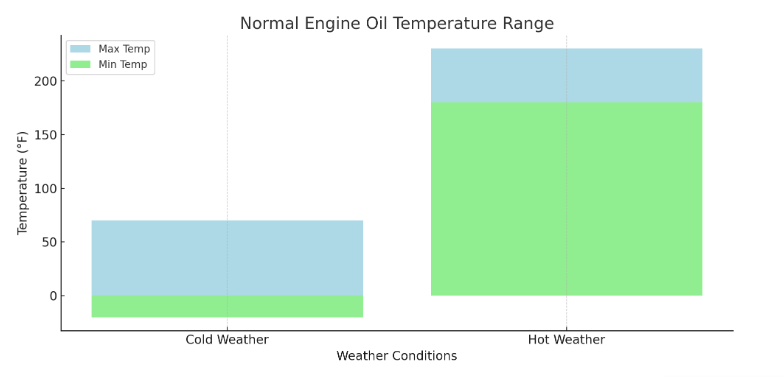Proper engine oil temperature is crucial for the longevity and efficiency of your vehicle. Engine oil serves as a lubricant, coolant, and cleaner, making it an essential component in your car’s operation. Oil requires optimal conditions to function effectively, and temperature plays a significant role.
This blog post goes into what constitutes normal engine oil temperature, why it matters, and how you can ensure your engine runs at its best. Let’s jump in.
Normal Engine Oil Temperature
Normal engine oil temperature typically ranges between 180°F to 210°F (82°C to 99°C). This range ensures that the oil maintains the right viscosity for lubricating engine components while also preventing excessive wear and tear. Temperatures outside this range can lead to either thickening or thinning of the oil, both of which can cause engine problems.

Why is Engine Oil Temperature Important?
Engine oil temperature is a key indicator of your engine’s overall health. It affects the oil’s viscosity, which in turn influences its ability to lubricate and protect engine parts. Maintaining an optimal temperature range ensures that the oil can effectively:
- Lubricate Engine Parts: Proper lubrication reduces friction between moving parts, minimizing wear and preventing overheating.
- Cool the Engine: Oil helps dissipate heat away from critical engine components.
- Clean the Engine: By trapping and suspending contaminants, oil keeps the engine clean and functioning efficiently.
Read Oil Drain Plug Torque Chart(Vehicles A to Z)
Factors Affecting Engine Oil Temperature
1. Driving Conditions
- City Driving: Frequent stops and starts can cause oil temperature to fluctuate, sometimes leading to higher readings.
- Highway Driving: Steady speeds typically maintain a consistent oil temperature, often within the normal range.
- Off-Roading: Harsh conditions and heavy loads can cause the engine to work harder, raising the oil temperature.
2. Ambient Temperature
The external temperature can significantly impact engine oil temperature. In colder climates, the oil may struggle to reach its optimal temperature, while in hot climates, it can overheat more easily.
3. Engine Load and RPM
High engine loads and RPMs (revolutions per minute) increase the engine’s demand for lubrication and cooling, thus raising the oil temperature.
4. Oil Type and Quality
The type and quality of engine oil used can also affect temperature. High-quality synthetic oils generally perform better at extreme temperatures compared to conventional oils.
Read How to Clean Funnel After Oil Change(Don’t Make These Mistakes)
Signs of Abnormal Engine Oil Temperature
Overheating
If the oil temperature gauge consistently shows high readings, your engine may be overheating. This can lead to oil breakdown and increased engine wear.
Thick or Thin Oil
If the oil is too thick or too thin, it can affect its ability to lubricate and cool the engine. This is often a result of the oil temperature being outside the normal range.
Reduced Performance
Abnormal oil temperature can cause reduced engine performance, including loss of power, poor fuel efficiency, and rough idling.
How to Monitor Engine Oil Temperature
Modern vehicles often come equipped with an oil temperature gauge or a digital display that shows real-time readings. It’s essential to monitor this gauge regularly, especially during long drives or in extreme weather conditions.
Using Aftermarket Gauges
For older vehicles or those without a built-in oil temperature gauge, aftermarket gauges are available. These can be installed to provide real-time monitoring and help prevent potential issues.
Maintaining Optimal Engine Oil Temperature
Maintaining the correct engine oil temperature involves several practices:
Regular Oil Changes
Regularly changing your engine oil ensures that it remains clean and effective at regulating temperature. Follow your vehicle manufacturer’s guidelines for oil change intervals.
Choosing the Right Oil
Selecting the right type of oil for your vehicle and driving conditions is crucial. Synthetic oils are generally better at maintaining stability at different temperatures.
Checking and Maintaining Cooling Systems
Your vehicle’s cooling system plays a significant role in maintaining oil temperature. Regularly check the coolant level, radiator, and thermostat to ensure they are functioning correctly.
The Role of Oil Coolers
For high-performance or heavy-duty vehicles, installing an oil cooler can be beneficial. Oil coolers help dissipate excess heat, ensuring that the oil remains within the optimal temperature range.
Benefits of Maintaining Normal Engine Oil Temperature
Keeping your engine oil at the correct temperature offers several benefits:
- Extended Engine Life: Proper lubrication reduces wear and tear, extending the engine’s lifespan.
- Improved Performance: The engine runs more efficiently when the oil is at the right temperature.
- Fuel Efficiency: Optimal oil temperature can improve fuel economy, saving you money in the long run.
Common Misconceptions About Engine Oil Temperature
Colder is Always Better
While it’s true that excessive heat can damage engine oil, running too cold isn’t ideal either. Oil needs to reach a certain temperature to flow properly and provide adequate lubrication.
Synthetic Oil Doesn’t Need Monitoring
While synthetic oil is more stable at extreme temperatures, it still requires regular monitoring and maintenance to ensure it performs optimally.
FAQs
What is considered a normal engine oil temperature?
Normal engine oil temperature usually ranges from 180°F to 210°F (82°C to 99°C).
Can driving habits affect engine oil temperature?
Yes, aggressive driving, frequent stops, and high RPMs can raise oil temperature.
How often should I check my engine oil temperature?
Regular monitoring is advisable, especially during long trips or extreme weather conditions.




